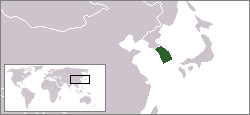| South Korea | |||
Location  | |||
Weapon & Flag
| |||
| Capital | Seoul | ||
|---|---|---|---|
| Government | republic | ||
| Currency | Korean Won (KRW) | ||
| Surface | 99646 | ||
| Population | 48 846 823 | ||
| Language | Korean | ||
| Religions | non-denominational 46%, Christians 26%, Buddhists 26%, Confucianists 1%, others 1% | ||
| Area code | 82 | ||
| TLD | .kr | ||
| Time zones | UTC 9 | ||
| Website | http://www.korea.go.kr/main | ||
South Korea, actually Republic of Korea, is a country in East Asia on the South Korean Peninsula (south of the 38th parallel). The capital of South Korea is Seoul.
Planning before the trip
To take with you to South Korea
Razors and deodorant as it is difficult to find and more expensive than normal.
To bring with you from South Korea
Kimchi
Facts about South Korea
History
South Korea's history, like the rest of the Korean Peninsula, has been marked by much of its neighbors China and Japanese claim to power. In 1910, South Korea became a Japanese colony. After World War II, the country became independent. In 1950, they were attacked by North Korea. The war ended in 1953. However, a peace treaty was never signed. Technically, the countries are still at war with each other. After this, there was an economic transformation with strong American support.
The locals
Climate
South Korea has an inland climate that is heavily influenced by the Asian mainland and warm, humid winds from the Pacific Ocean. The summer gets hot and humid due to the winds. The temperature can then be up to 40 degrees C. The winters are cold and dry with a few degrees below zero, often with snow, but it will be slightly milder in the south. In late summer, there is a risk of typhoons. There is a monsoon in the country.
Holidays
Korea's traditional holidays follow the lunar calendar, so they fall on different dates each year. The two largest holidays, Seollal and Chuseok, are family holidays and during these everyone usually returns to their hometowns, which means that all forms of transport are fully booked.
- Shinjeong (신정), means New Year's Day: the first day, in January.
- Seollal (설날), the first day of the first month of the lunar calendar, also known as the Korean New Year. Families gather, eat traditional food (especially Ddugguk (떡국)) and celebrate their ancestors with a ceremony. This weekend lasts for 3 days and includes the evening before and the second day. Many shops and restaurants are closed during these three days, so this is not the ideal time to visit the country.
- Sameeljjeol (삼일절, 3.1 절): March 1, in memory of the resistance movement during the war of 1919.
- Orininal (어린이 날): means children's day, 5 May.
- Buchonnim osinnal or sawolchopa-il: means the birthday of the Buddha, the eighth day of the fourth month of the lunar calendar.
- Hyeonchung-il (현충일): means Memorial Day, June 6th. In memory of the people who gave their lives for the nation.
- Gwangbokjjeol (광복절): means Freedom Day, August 15th. In memory of the liberation of the Korean Peninsula from the Japanese at the end of World War II.
- Chuseok (추석), often called Korea's Thanksgiving Day. Celebrated on the fifteenth day of the eighth month of the lunar calendar (usually in September or October). Koreans celebrate by eating traditional food, usually a rice cake called songpyeon (송편). This weekend lasts for three days.
- Gaecheonjeol (개천절): 3 October. In memory of the first formation of the nation.
- Christmas (성탄절) has become a major holiday in Korea due to the large number of Christians converted in recent times. As such, it is an ideal time to visit the country and soak up the festive atmosphere and perhaps listen to some Korean variations of popular Christmas carols.
Regions
Cities
Getting to South Korea
It is impossible to travel directly between North Korea and South Korea. The border itself is the best guarded in the world and a tourist attraction in itself (see Panmunjeom). Currently, there are only two options to get to and from South Korea: by plane and boat.
In addition to the national airlines Korean Air and Asiana Many of the world's major airlines fly to South Korea, most to Seoul. The fastest connection from Sweden is with Finnair via Helsinki and with Air China (codeshare with SAS) via Beijing to Busan, Daegu and Seoul.
From Japanese and Vladivostok, Russia.
Relocation in South Korea
Korean Air and Asiana fly on some domestic flights. South Korea is not big on the surface, so you get there almost as fast by train.
Korail [1] operates from Seoul to other major cities.
Payment
Korean Won.
Credit cards are not accepted in markets and the like.
Many ATMs do not accept international cards but in Seoul and at the airports it is no problem to find one that accepts international cards.
Accommodation
Food and drinks
In Korea, people eat about the same food as in the rest of Asia, rice and soup are included in most dishes. A Korean meal usually consists of a meat or fish dish, a bowl of rice, a few small bowls of other vegetables, kimchi and sometimes even a bowl of soup eaten with a spoon.
- Kimchi spiced cabbage served with many dishes. Perhaps the most famous ingredient.
- Bulgogi korean barbeque.
- Soju local spirits.
It is also eaten dog and snake in South Korea, although not very common.
To see

To do
Work
Communication
Although the language of South Korea is Korean, everyone who works in tourism speaks English. In Seoul, most people understand English.
- Internet In larger cities, e.g. Seoul has plenty of internet cafes.
- GSM phones do not work in South Korea. However, 3G phones work normally.


